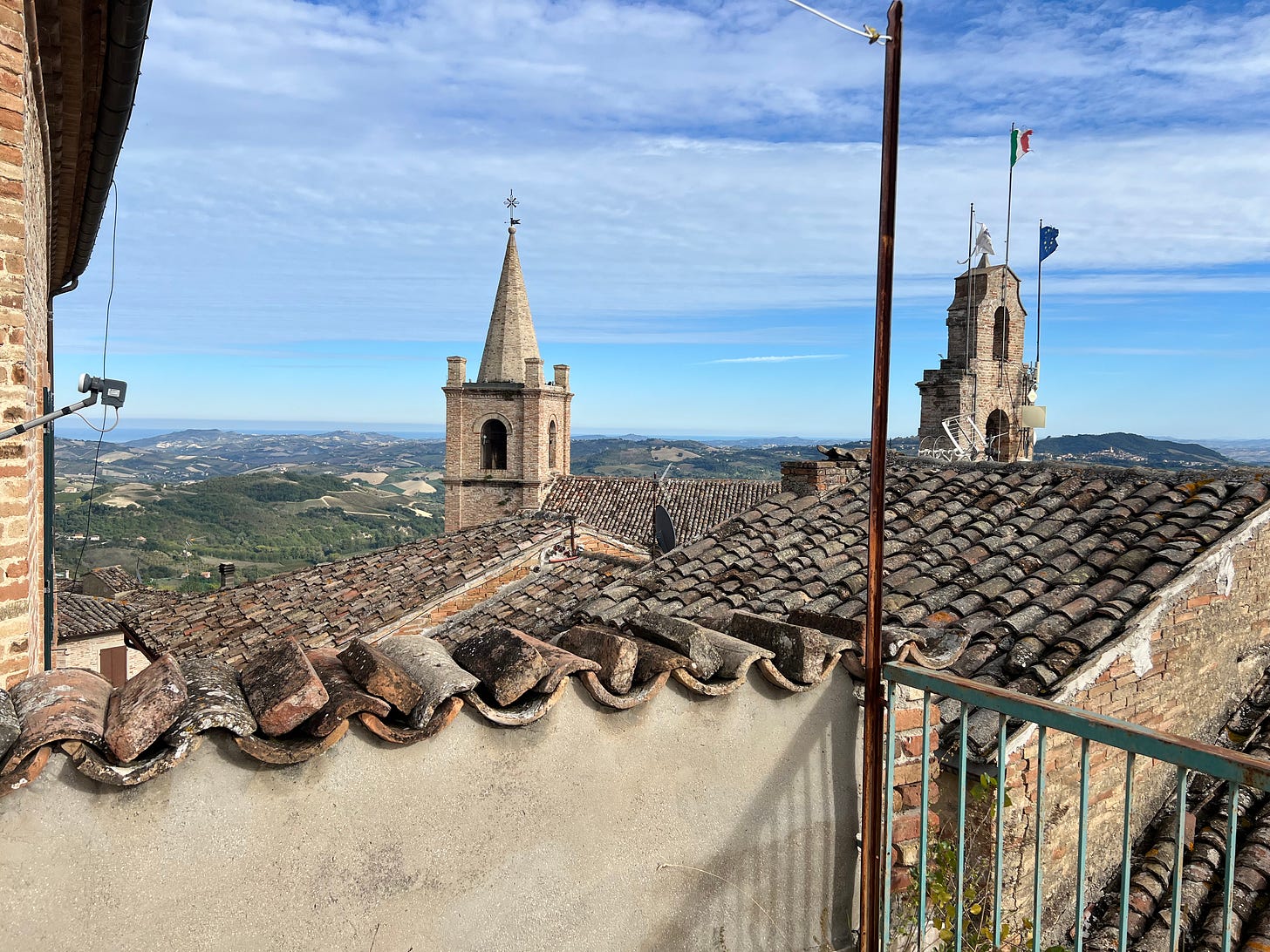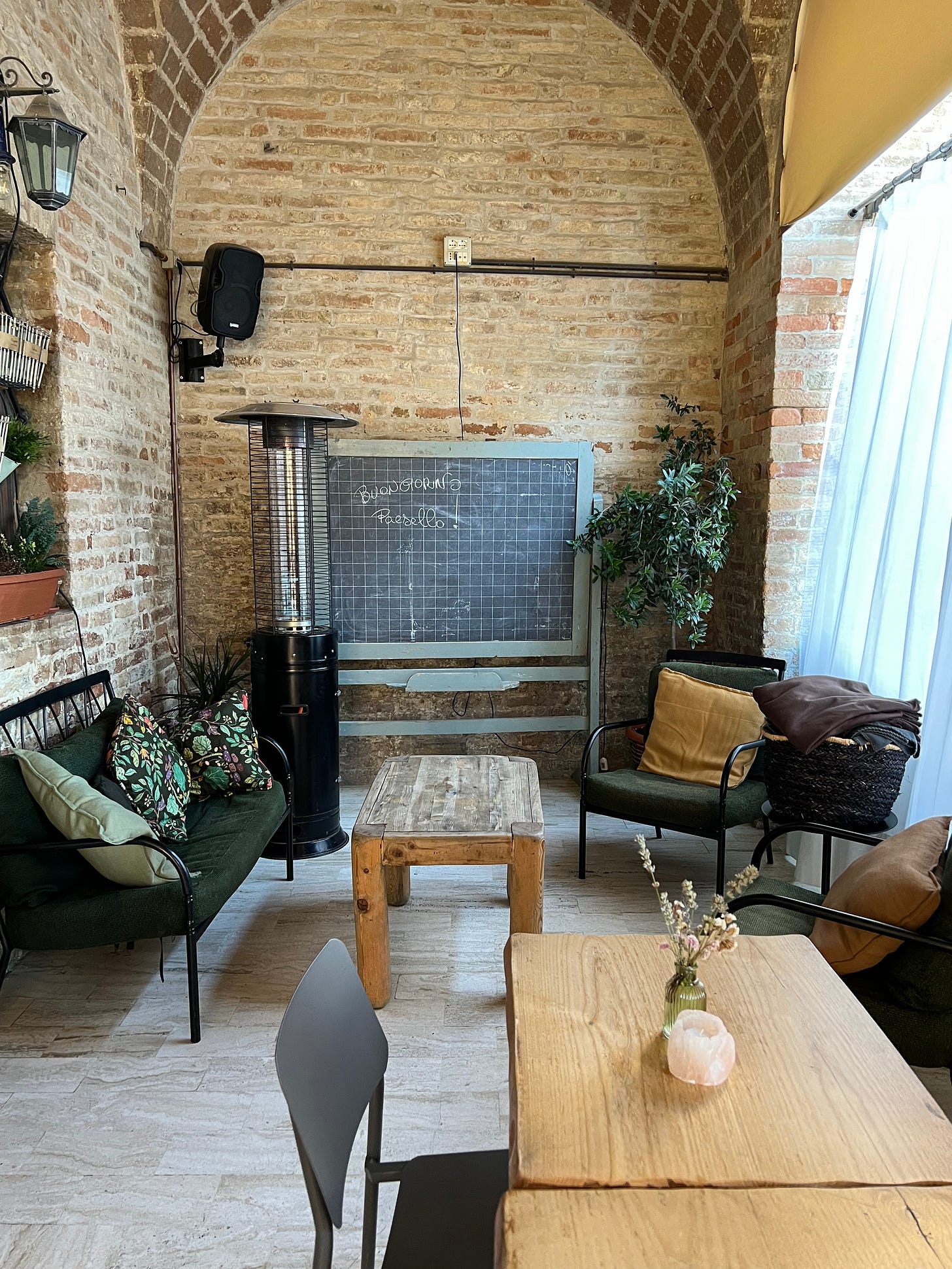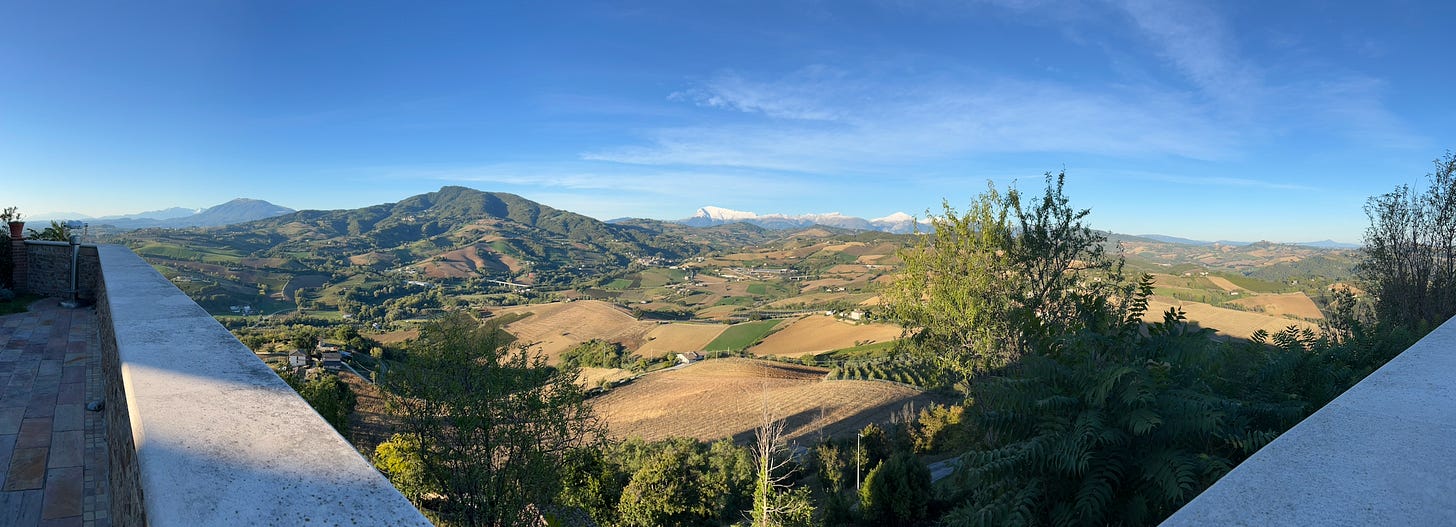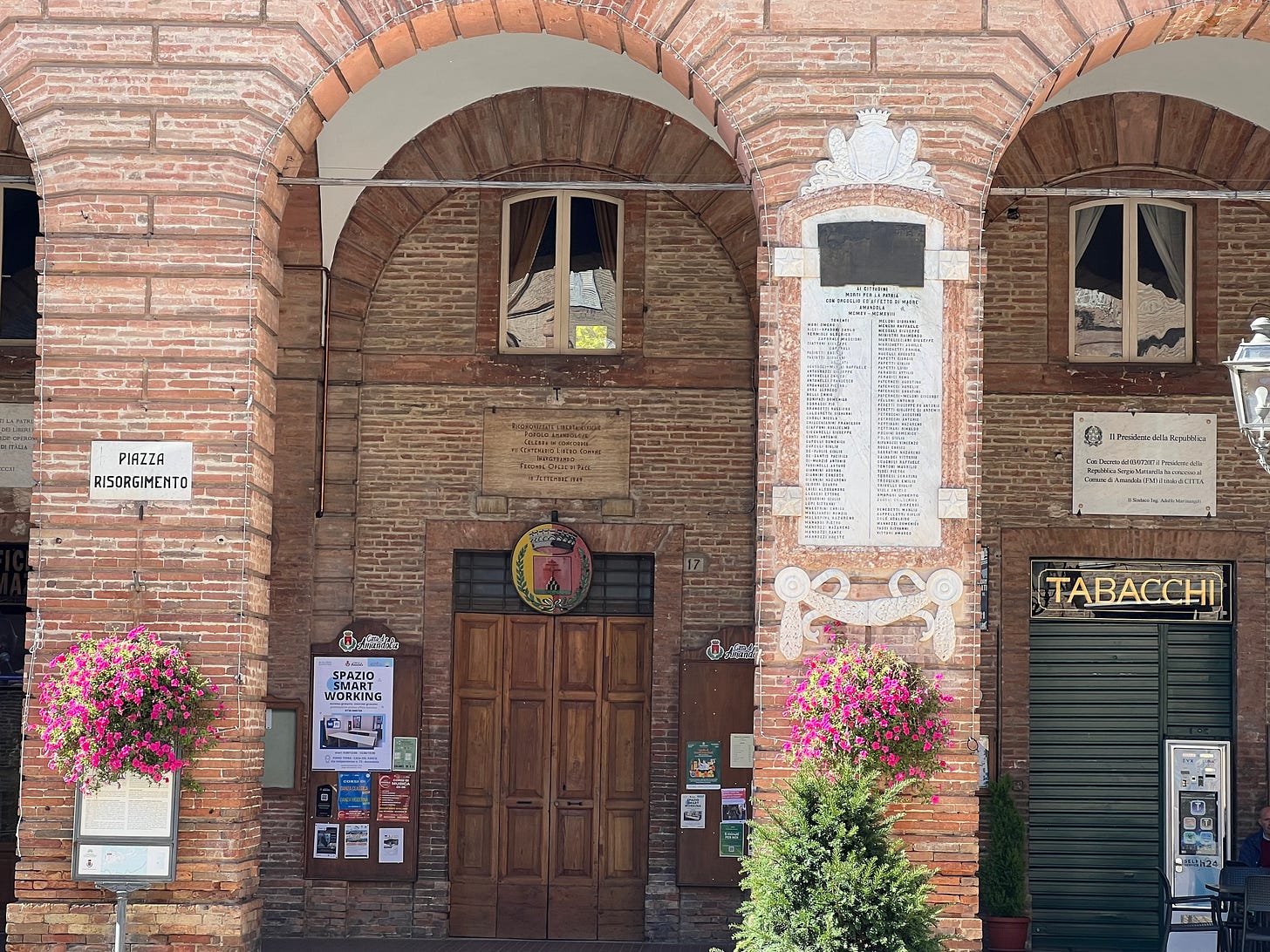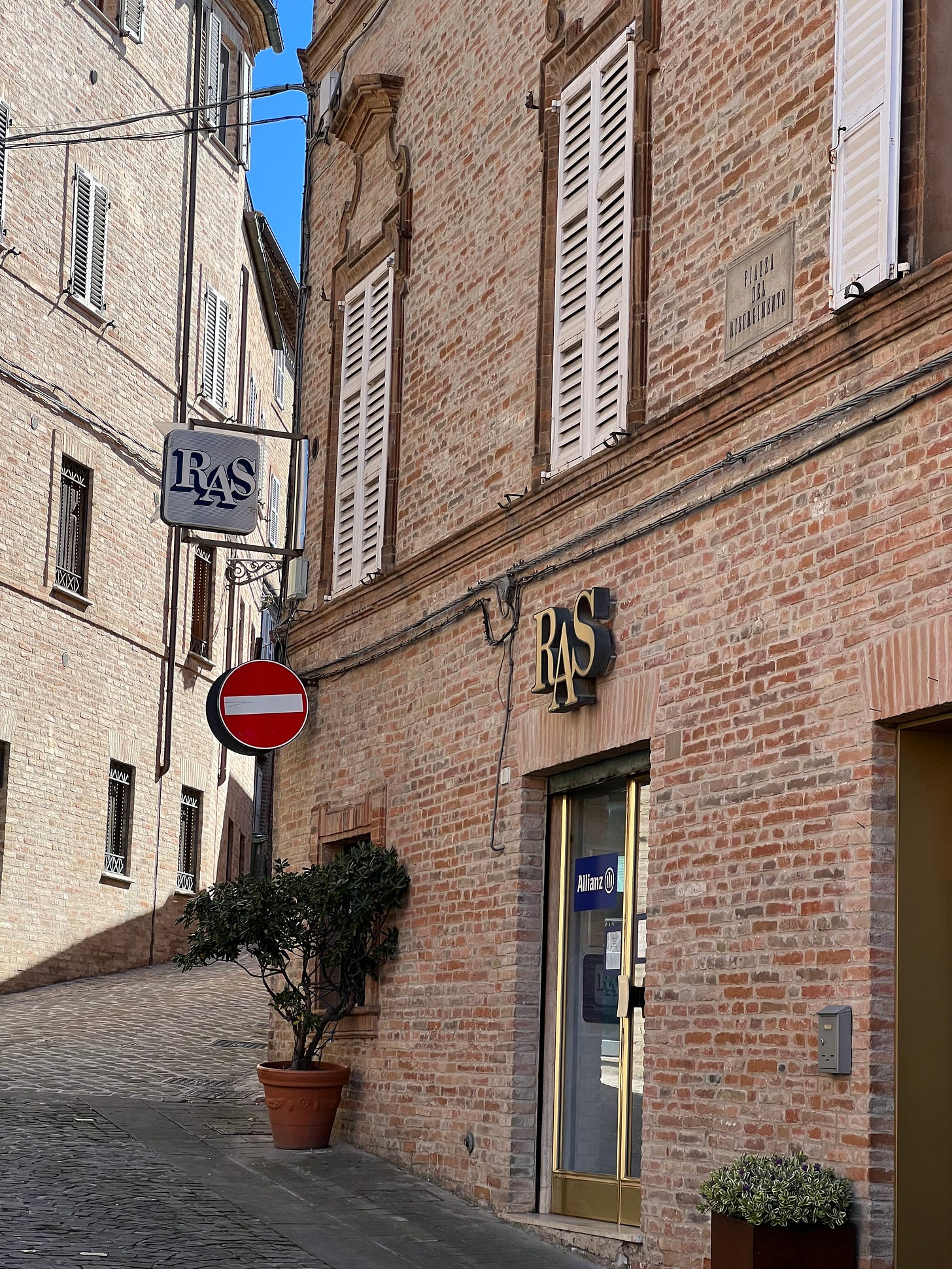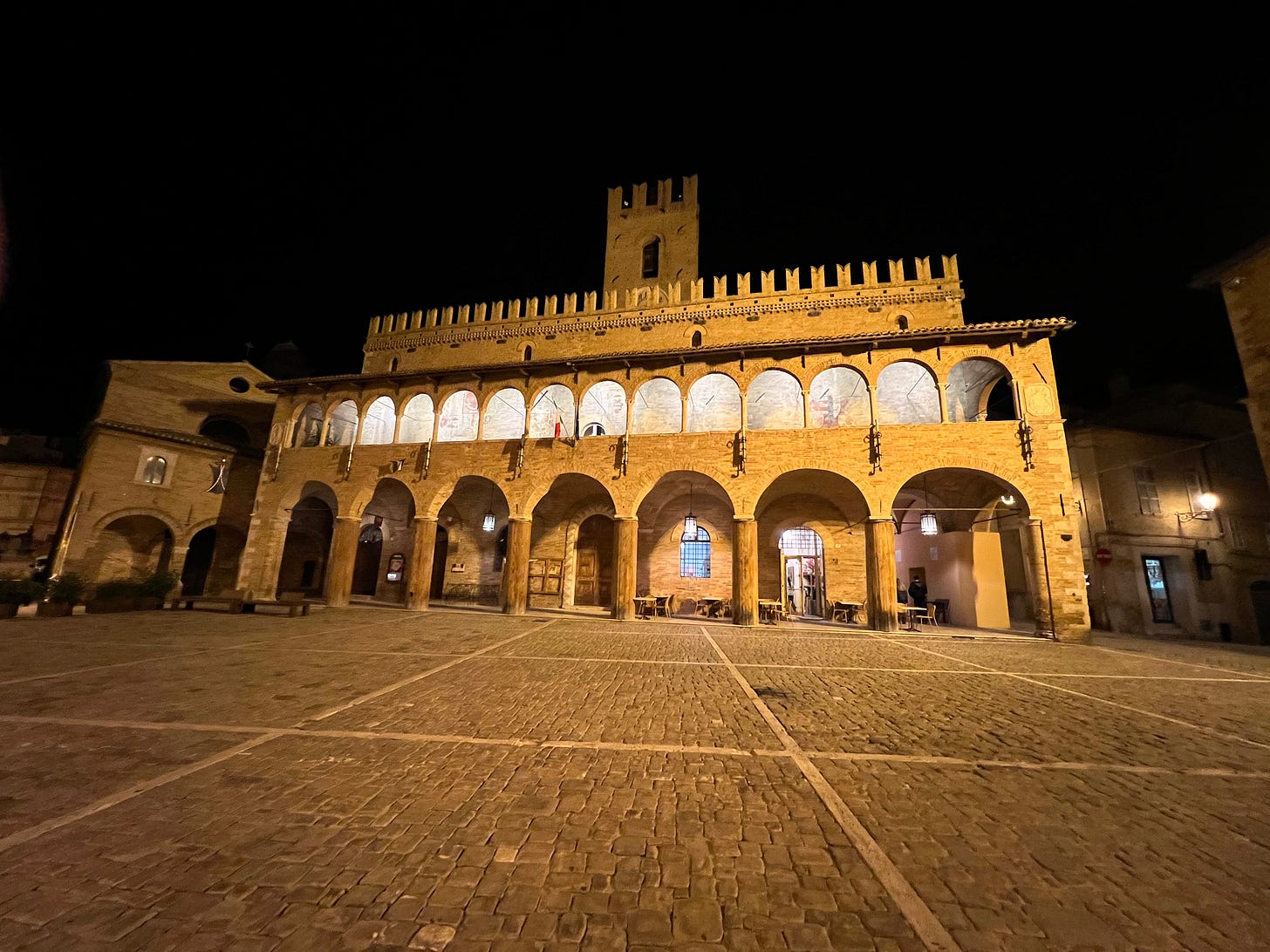Il silenzio che rigenera: viaggio nel sud delle Marche con ITS Italy
The Silence That Heals: A Journey Through Southern Marche with ITS Italy
C’è qualcosa nelle Marche che resiste alla tentazione di mostrarsi.
Un’eleganza discreta, un senso di misura raro. Mentre altre regioni competono per farsi notare, qui tutto sembra curato con precisione certosina ma senza ostentazione — come pennellate su una tela già perfetta.
Campi ordinati, filari disegnati a mano, colline che sembrano respirare.
Siamo arrivati nei primi giorni di ottobre, con un tempo limpido e fresco dopo le piogge dei giorni precedenti. I Monti Sibillini, già imbiancati, si stagliavano all’orizzonte come una promessa d’inverno. Le nostre tappe erano solo parzialmente definite: Montedinove — uno dei borghi dove
ha deciso di operare — era la destinazione principale. Ma avevamo lasciato spazio alla curiosità, a due visite “a sorpresa”, in avanscoperta: Amandola e Camerino.Ripatransone, la sorpresa più dolce
Il caso ha voluto che pernottassimo alle porte di Ripatransone, un piccolo gioiello appollaiato tra colline e Adriatico, con un panorama che pare un mosaico vivente. È un paese straordinario: elegante senza essere pretenzioso, con scorci da film e quella tipica accoglienza marchigiana che non ti travolge ma ti accompagna.
Senza saperlo, ci siamo ritrovati nel mezzo di una festa di paese.
Decine di persone mangiavano e brindavano in piazza, ma l’atmosfera era più quella di una cena di famiglia allargata che di un evento organizzato. Nessun palco, nessuna formalità — solo comunità viva, spontanea, felice di condividere. Ci siamo sentiti ospiti inattesi ma benvenuti, parte di un equilibrio raro: il piacere semplice dello stare insieme.
La mattina dopo, poco dopo l’alba, abbiamo lasciato Ripatransone diretti verso Montedinove. I pochi chilometri sono diventati un viaggio dentro il paesaggio.
Impossibile guidare senza fermarsi ogni tanto: ogni curva offriva un quadro nuovo, con i contadini già al lavoro tra gli ulivi, il rumore ovattato della terra che si sveglia.
Attraversando Cossignano, piccolo borgo ordinato come un presepe, e poi Montalto delle Marche, fiero e leggermente più severo, siamo arrivati a Montedinove prima delle otto.
Montedinove, la calma operosa
Il paese era già illuminato da una luce chiara, quasi metafisica.
Alcuni operai del Comune attendevano le nove per iniziare i lavori, “non un minuto prima del rintocco della campana, per non disturbare”.
Montedinove è gestito con la precisione di una clinica svizzera: pulito, ordinato, senza una cicca per terra. C’è una calma che non è assenza di vita, ma equilibrio.
Nell’attesa del nostro incontro con il sindaco, abbiamo fatto un giro in silenzio. Si sentivano solo i nostri passi sulle pietre, il rumore leggero del vento. È stato un momento quasi mistico.
Quando ha aperto il piccolo bar della piazza, ci è venuto naturale aiutare i ragazzi che lo gestiscono a preparare i tavolini — più per partecipare che per cortesia.
Poi, la giornata è proseguita con lo stesso ritmo: lento, vero, umano.
Con il sindaco — una persona che, dopo anni di dialoghi, stiamo imparando sinceramente ad apprezzare — abbiamo parlato del passato e del futuro del borgo, di un progetto più ampio che coinvolge anche Rotella e Amandola, sostenuto da fondi pubblici spesi bene. Sì, bene: qui si vede la differenza tra il denaro investito e quello disperso.
Amandola, porta dei Sibillini
Amandola è più grande, più viva, più “di passaggio”. È la porta d’ingresso al Parco dei Monti Sibillini e si sente: qui la natura detta i ritmi.
La prima visita è stata volutamente anonima — volevamo guardarla senza filtri, prima dell’incontro ufficiale con il sindaco. Ma bastano pochi minuti per capire che c’è energia.
Il giorno dopo, nonostante una grande fiera che ci ha fatto deviare a lungo all’altezza di Comunanza, siamo tornati.
L’incontro con il sindaco (e una collega assessore) doveva durare venti minuti.
È durato più di un’ora e mezza. Tra una chiacchiera e l’altra ci ha donato un bellissimo libro sui Sibillini, ma soprattutto ci ha regalato una lezione di appartenenza.
Amandola è pronta. Ha un tessuto civico forte, spazi pubblici attrezzati, persino un cartello in piazza che indica il coworking comunale.
Un piccolo segno, ma potentissimo: in un’Italia che fatica a trattenere i giovani, qui si crea spazio per restare, per lavorare, per immaginare.
Un dettaglio che mi ha colpito: un’agenzia assicurativa in centro espone ancora l’insegna “RAS” accanto a una più recente “Allianz”.
RAS non esiste più da vent’anni, ma nessuno ha voluto toccare quella scritta.
È un piccolo atto di rispetto per la memoria collettiva. E forse anche questo è rigenerazione.
Offida, Ascoli, Camerino
Il viaggio nelle Marche si è allungato naturalmente.
Una deviazione ci ha portati a Offida, tra le sue case di mattoni caldi.
Poi Ascoli Piceno, elegante e vivace, con le sue piazze in travertino: troppo bella per restarci solo poche ore, troppo viva per non tornarci.
Ultima tappa: Camerino.
Una visita breve, silenziosa, quasi in punta di piedi.
Camerino è una città ferita, ma non piegata. Il terremoto ha lasciato cicatrici profonde, eppure l’università, la comunità, la forza civile stanno lentamente ricucendo il tessuto urbano e umano.
Sono arrivato presto, con la nebbia ancora sospesa sui tetti. C’era malinconia, sì, ma anche una voglia silenziosa di ricominciare.
Non so ancora se e come potremo essere utili con ITS Italy — ma la volontà di provarci c’è. Perché certi luoghi ti chiamano non con la voce, ma con la dignità.
Un amico, l’ingegner Carlo Morosi, originario proprio di Camerino, mi ha mandato un video che racconta tutto questo meglio di qualsiasi parola.
Guardatelo. E ditemi se non sentite anche voi il desiderio di premiare questa terra.
The Silence That Heals: A Journey Through Southern Marche with ITS Italy
There’s something in Le Marche that resists the temptation to show off.
A discreet elegance, a rare sense of proportion. While other regions compete to be noticed, here everything feels meticulously cared for — but never ostentatious. Like brushstrokes on an already perfect canvas: orderly fields, hand-drawn rows of vines, hills that seem to breathe.
We arrived in the first days of October, with crisp, clear air after the rains. The Sibillini Mountains, already dusted with snow, stood on the horizon like a quiet promise of winter. Our itinerary was loosely planned: Montedinove — one of the villages where ITS Italy has chosen to work — was the main destination. But we had left room for curiosity, with two “surprise” scouting visits to Amandola and Camerino.
Ripatransone: the sweetest surprise
By chance, we spent the night just outside Ripatransone, a small gem perched between the hills and the Adriatic, with a panorama that looks like a living mosaic. It’s an extraordinary town — elegant without being pretentious, cinematic in its views, and with that typical marchigiana warmth that doesn’t overwhelm you, but quietly welcomes you.
Without knowing it, we arrived in the middle of a local festival. Dozens of people were eating and toasting in the square, but it felt less like an event and more like an extended family dinner. No stage, no formalities — just a living, breathing community, happy to share. We felt like unexpected but welcome guests, part of a rare balance: the simple joy of being together.
The next morning, just after dawn, we left Ripatransone heading toward Montedinove. The few kilometers became a journey through the landscape itself. It was impossible not to stop along the way — each curve offered a new painting, with farmers already working among the olive trees, and the soft sound of the earth awakening.
Passing through Cossignano — tidy as a nativity scene — and then Montalto delle Marche, proud and slightly sterner, we reached Montedinove before eight o’clock.
Montedinove: the quiet of precision
The town was already bathed in a clear, almost metaphysical light. A few municipal workers were waiting for nine to begin their tasks — “not a minute before the bell,” they said, “so as not to disturb anyone.” Montedinove is run with the precision of a Swiss clinic: spotless, orderly, without a single cigarette butt on the ground. Its calm is not the absence of life, but its balance.
While waiting for our meeting with the mayor, we wandered in silence. Only our footsteps and the whisper of the wind broke the stillness. It was almost mystical. When the small bar in the square opened, we naturally helped the young owners set up the tables — more out of a wish to participate than courtesy. The day continued at that same rhythm: slow, genuine, human.
With the mayor — someone we’ve come to genuinely appreciate after years of dialogue — we spoke about the past and future of the village, and about a wider project involving Rotella and Amandola, supported by well-used public funds. Yes, well used: here you can tell the difference between money that’s invested and money that’s wasted.
Amandola: gateway to the Sibillini
Amandola is larger, livelier, more “on the way.” It’s the gateway to the Sibillini National Park, and you can feel it — nature sets the rhythm here. Our first visit was intentionally anonymous: we wanted to see the town without filters, before our official meeting with the mayor. It took only a few minutes to sense the energy.
The next day, despite a large fair that forced us to detour for miles around Comunanza, we returned. The meeting with the mayor (and a city council member) was supposed to last twenty minutes. It lasted over an hour and a half. Between stories and laughter, they gifted us a beautiful book about the Sibillini — and, more importantly, a lesson in belonging.
Amandola is ready. It has a strong civic fabric, well-equipped public spaces, even a sign in the main square pointing to the municipal coworking hub. A small thing, yet powerful: in an Italy struggling to keep its youth, here there’s room to stay, to work, to imagine.
One small detail struck me: an insurance agency in the center still displays its old RAS sign next to a newer Allianz one. RAS has been gone for twenty years, but no one wanted to remove the old lettering. It’s a quiet act of respect for collective memory. And perhaps that too is regeneration.
Offida, Ascoli, Camerino
Our journey through Marche naturally stretched out. A detour took us to Offida, with its warm brick houses. Then to Ascoli Piceno — elegant, lively, its travertine piazzas too beautiful to leave after only a few hours, too alive not to return.
Finally, Camerino — a brief, silent visit, almost on tiptoe. Camerino is a wounded city, but unbroken. The earthquake left deep scars, yet the university, the community, and civil strength are slowly stitching together both its urban and human fabric.
I arrived early, with the morning mist still hanging over the rooftops. There was melancholy, yes, but also a quiet desire to begin again. I don’t yet know if or how we can contribute with ITS Italy — but the will to try is there. Because some places don’t call you with their voice, but with their dignity.
A friend, engineer Carlo Morosi — born right here in Camerino — sent me a video that captures it all better than any words could. Watch it, and tell me if you don’t feel the same impulse to reward this land.



